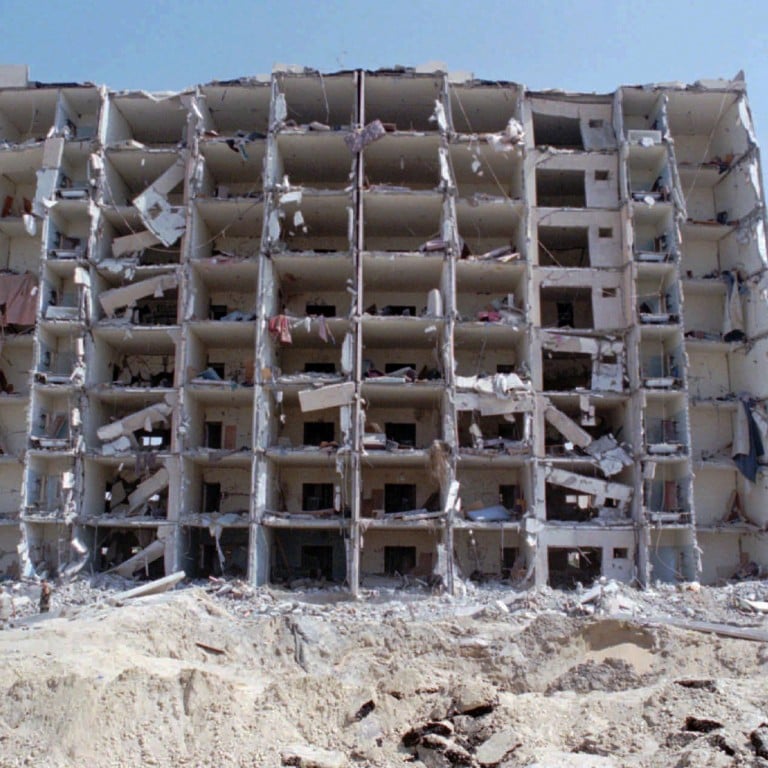
Long hunt over: Mastermind of deadly 1996 Khobar Towers bombing is captured
A man described as the mastermind of the 1996 Khobar Towers bombing that killed 19 American servicemen in Saudi Arabia has been captured, a US and a Saudi official said, ending a nearly two-decade manhunt for one of the FBI’s most-wanted terrorists.
Ahmed al-Mughassil was arrested in Beirut and transferred to Riyadh, the Saudi capital, to the Saudi newspaper Asharq Alawsat reported Wednesday. The Saudi Interior Ministry and Lebanese authorities had no immediate comment on the capture.
The 48-year-old suspect was described by the FBI in 2001 as the head of the armed wing of the once-active but shadowy Saudi Hezbollah group. The FBI had offered a US$5 million reward for information leading to his arrest.

The June 25, 1996, truck bombing at the Khobar Towers, an eight-story dormitory in eastern Saudi Arabia for US Air Force personnel assigned to the Gulf, killed 19 Americans and wounded 372 more. It was the deadliest such attack targeting US forces since the 1983 bombing of the US Marines’ barracks in Beirut that killed 241 American servicemen.
Al-Mughassil, also known as Abu Omran, is one of 14 people named in a 2001 indictment in Alexandria, Virginia, in connection with the bombing. Charges include murder of federal employees and bombing resulting in death.
The US indictment said that elements of the Iranian government inspired, supported and supervised members of the Saudi Hezbollah group in the Khobar Towers attack, but it stopped short of naming any Iranian officials.
The Asharq Alawsat newspaper said al-Mughassil was arrested after Saudi authorities identified his whereabouts in Lebanon.
A Saudi official said Wednesday that al-Mughassil was detained two weeks ago after arriving in Beirut from Iran. He allegedly tried to seek cover in a southern Beirut neighborhood that is a stronghold of Lebanon’s Hezbollah. The security official said Saudi intelligence believes that four others wanted in the bombing are living in Iran.
The Saudi and a US official who also confirmed the arrest spoke on condition of anonymity because they were not authorised to publicly discuss the matter.
Saudi Arabia has never directly blamed Iran — its regional rival — for the attack, and Iran has repeatedly denied being involved.
In 2006, US District Judge Royce C. Lamberth ruled the Iranian government financed the bombing, ordering it to pay US$254 million to the attack’s victims.
US State Department spokesman John Kirby declined to comment on the capture but said: “The United States continues to stand with the victims and families harmed by this attack, and we’re going to continue working with Saudi Arabia and the international community to bring to justice all the perpetrators of it.”
In the attack, militants parked a fuel tanker truck just outside the shallow perimeter of the apartment complex, 25 metresfrom one of the dormitories. The blast tore the face off one side of the building, leaving a massive crater.
The US later moved its Air Force contingent to a compound in a remote stretch of desert south of Riyadh before withdrawing its troops from the kingdom in 2003.
Details of al-Mughassil’s life remain elusive. He was born in Saudi Arabia’s eastern city of Qatif, a predominantly underdeveloped Shiite region that is home to the kingdom’s vast oil reserves.
Toby Matthiesen, who has written extensively on Saudi Shiites in a book titled The Other Saudis, said al-Mughassil was rumored to have gone to Iran after the 1979 revolution and is believed to have fought at some point in Lebanon’s 15-year civil war that ended in 1990.
The Saudi Hezbollah group, also called Hezbollah al-Hijaz, was established in Saudi Arabia’s Eastern Province in 1987 in retaliation to the killing of more than 400 Iranians who died in clashes that same year with Saudi riot police in Mecca during the annual hajj pilgrimage.
Three other Saudis are still on the FBI’s most-wanted list for the Khobar attack: Ali al-Hoorie, Abdelkarim al-Nasser and Ibrahim al-Yacoub.
